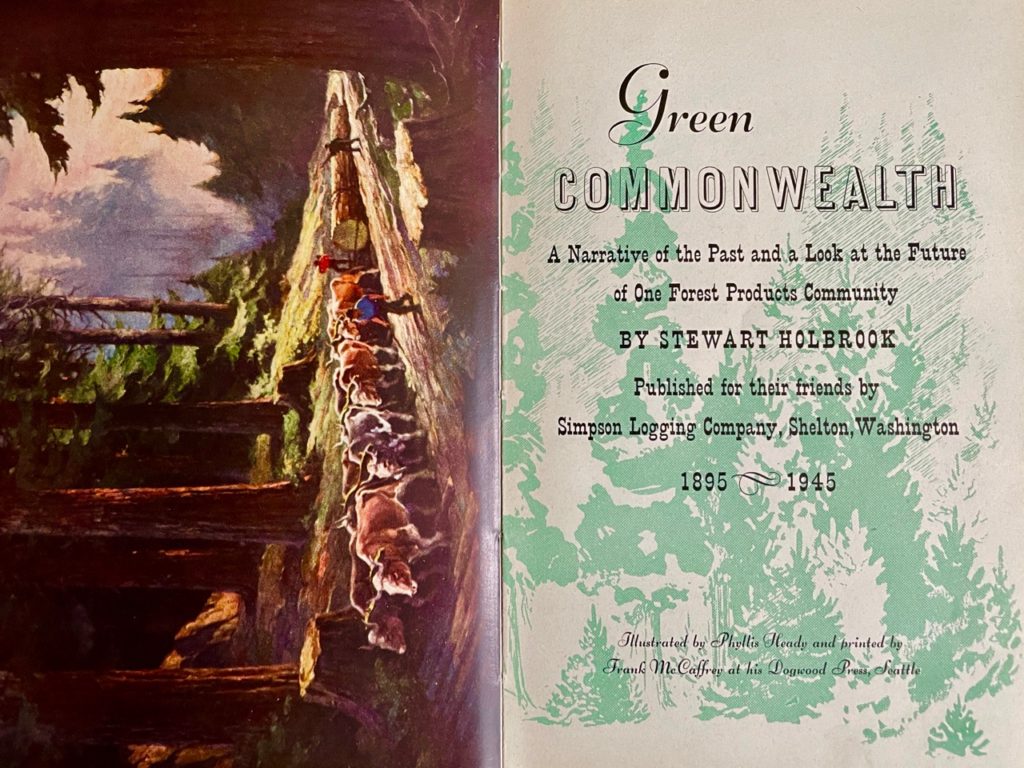by Michael Schepps (you’ll find a full bio, including a link to Schepps’s new book, Split Aces, at the end of the article)
Throughout much of his life, the writer Stewart Holbrook (1893-1964) was considered “perhaps the Pacific Northwest’s best-known personality.” In seemingly endless articles that garnered a devoted local readership and were often excerpted in the national press, Holbrook captured and caricatured what he called the country’s “Far Corner” during its rapid mid-20th century modernization, painting an indelible portrait whose legacy lives on today. But Holbrook did more than just portray the Northwest. His stylistic innovations in the field of creative nonfiction are the equal of the more-celebrated Joseph Mitchell, but he has never received the credit he deserves.
One of Holbrook’s primary interests was timber. After years of working in Northwest logging camps (as well as sojourns in the theater world and on the battlefields of France), he took a position in Portland in 1923 as the associate editor of the 4-L Lumber News, the mouthpiece for a government-and-industry-backed labor union meant to be an alternative to the radical Industrial Workers of the World, or Wobblies. Seeking to supplement his income through freelancing, he found a home in the pages of The Oregonian. There, he regaled readers with histories, character studies, and reportage about whatever crossed his path, including his observations during drinking sessions with the grizzled waterfront tough Edward “Spider” Johnson.
Written with considerable brio while invoking a demi-realm of myth and history, these articles are much of the reason for Holbrook’s lasting influence. In particular, his vivid evocation of the Pantagruelian proportions of Augustus Erickson’s gargantuan bar and the sinister chthonic depths of the city’s Shanghai Tunnels helped create the popular perception of nineteenth-century Portland as an “anything-goes” fantasia.
In Holbrook’s depiction, a wild drinking session at the “longest bar in the world” might end with the drinker being drugged and trafficked (alongside dead men and cigar-store statues) through tunnels honeycombing the waterfront, only to wake up in chains (while facing a year’s harsh service) on a rotting clipper ship rounding the Horn.

Although Holbrook’s work appeared in national publications such as The New Yorker, The American Mercury, and Esquire at the same time his East Coast contemporary Joseph Mitchell was publishing the character sketches that would make him famous as a progenitor of what is called “new journalism,” he has never received adequate credit for his own innovations in prose. When literary historian Norman Sims named Joseph Mitchell a major influence on “new journalism” (or literary journalism) he pointed to Mitchell’s penchant for “merging fiction and nonfiction, the symbolic and the literal, biography and reportage, the real and the imagined landscapes of the city.” What is true for Mitchell is equally true for Holbrook.
Along with Mitchell, Holbrook wrote from a participant-observer perspective and often focused on “lowbrow” life, which are valuable tools today in any nonfiction writer’s toolkit. Of course, he shared some of Mitchell’s more questionable practices too, including the use of composite characters, invented dialogue, and hyperbole in the service of a larger truth (practices for which Mitchell has more recently suffered a dramatic reappraisal, with some even wondering if he was truly a journalist).
Read as imaginative literature or “literary journalism,” Holbrook’s work remains clean and compelling, the deeper truths beneath the varnish of embellishment and hyperbole shining through as bright as ever. But as serious history, it is greatly lacking. One historian has gone so far as to say that “repetition of a Holbrook fiction is a sure indication of lazy scholarship and gullibility.”
During his lifetime, Holbrook published over 30 books and countless articles. At its best, his work ties together strands of deep research and interviewing, a bright sense of place and character, and a singularly appealing voice. The East Coast transplant understood an essential truth about the region where he made his home and set his writing: it was a place of malleability and reinvention whose story had not yet been fully told—a place where the telling of its story could both define it and make it new.
Michael Schepps is a writer, editor and publisher in Portland. His exploration of authorial invention and identity continues in his debut noir novella Split Aces, available now from Korza Books, in both e-book and print. To read more of his work, visit MLSchepps.com.

Leave a Reply